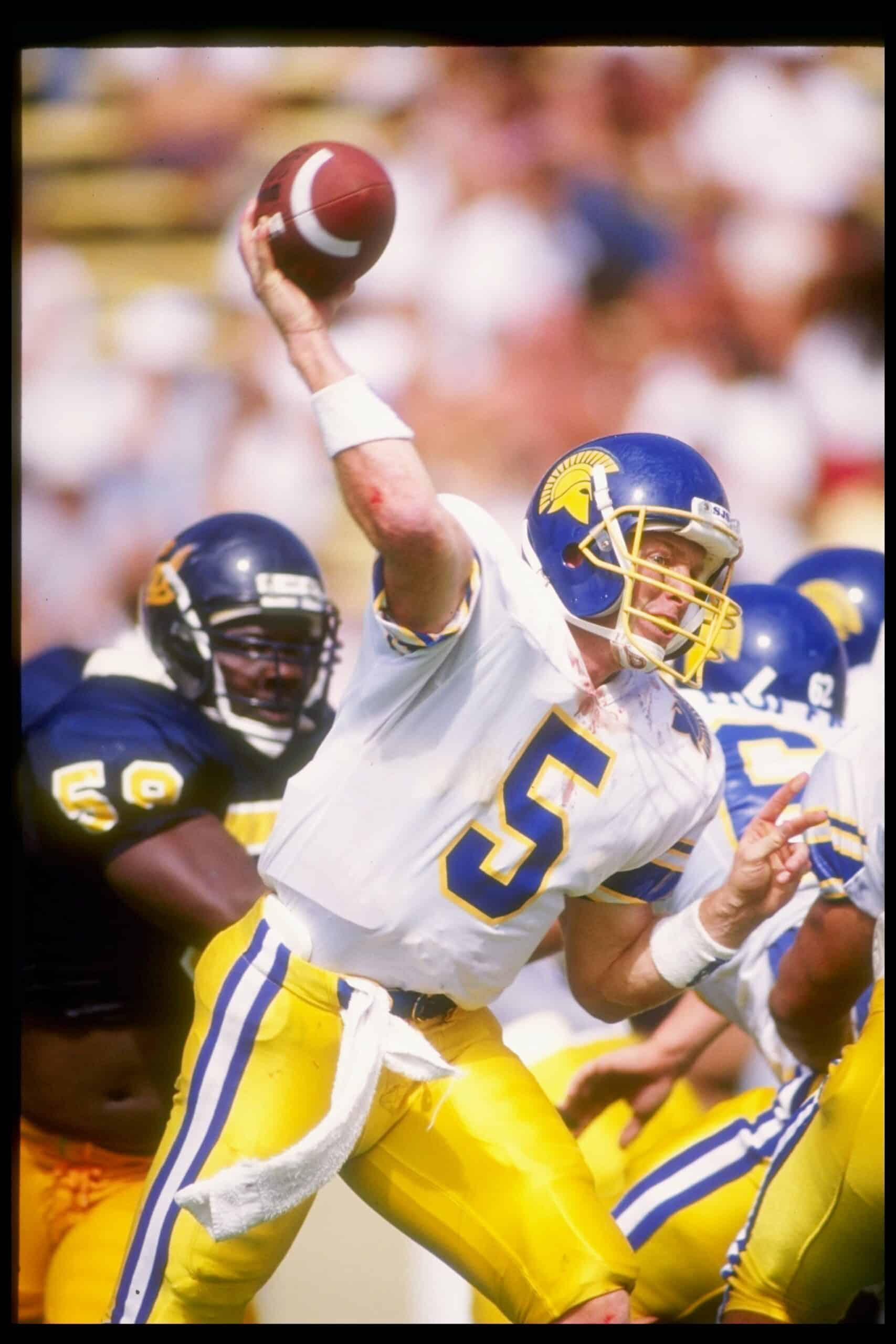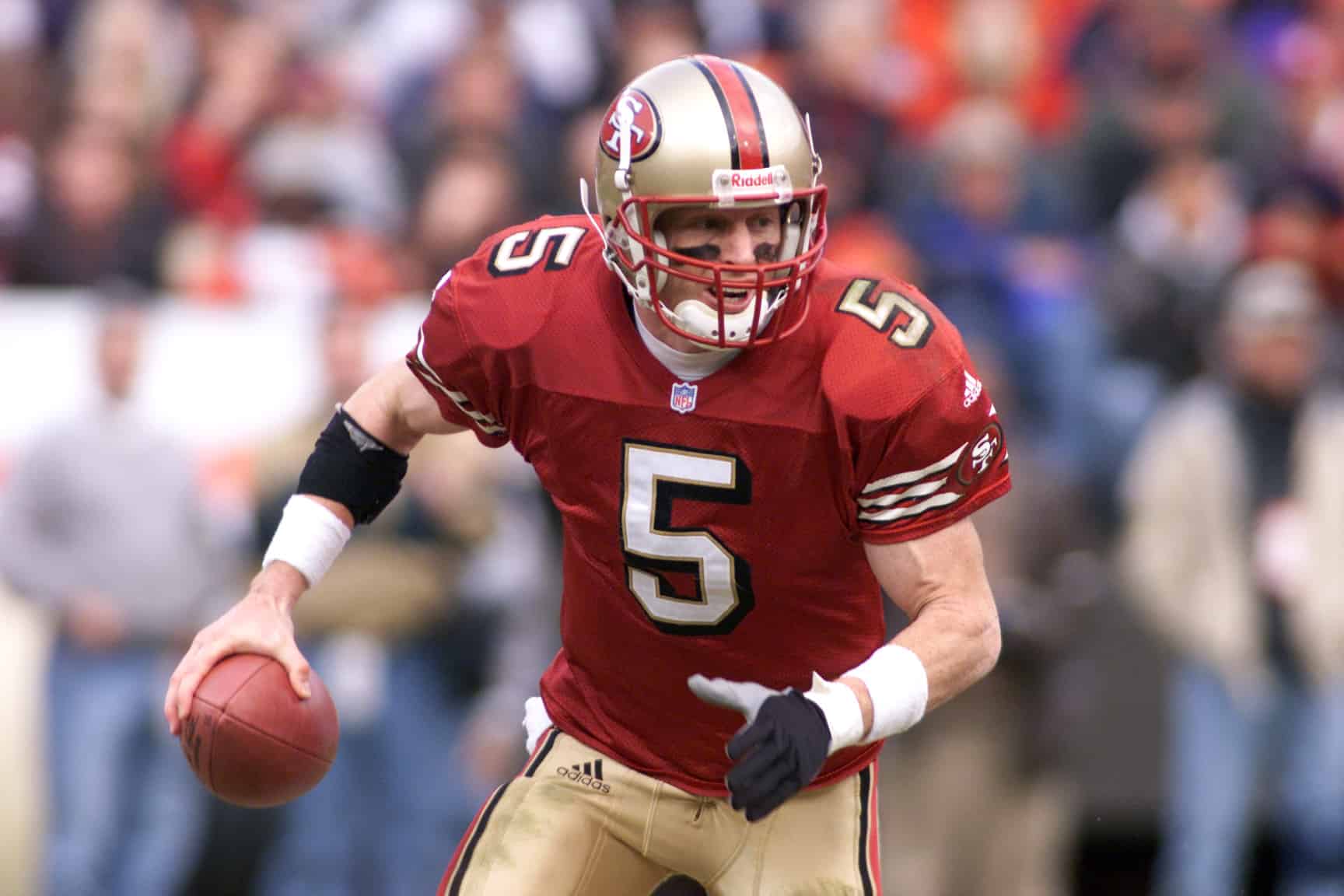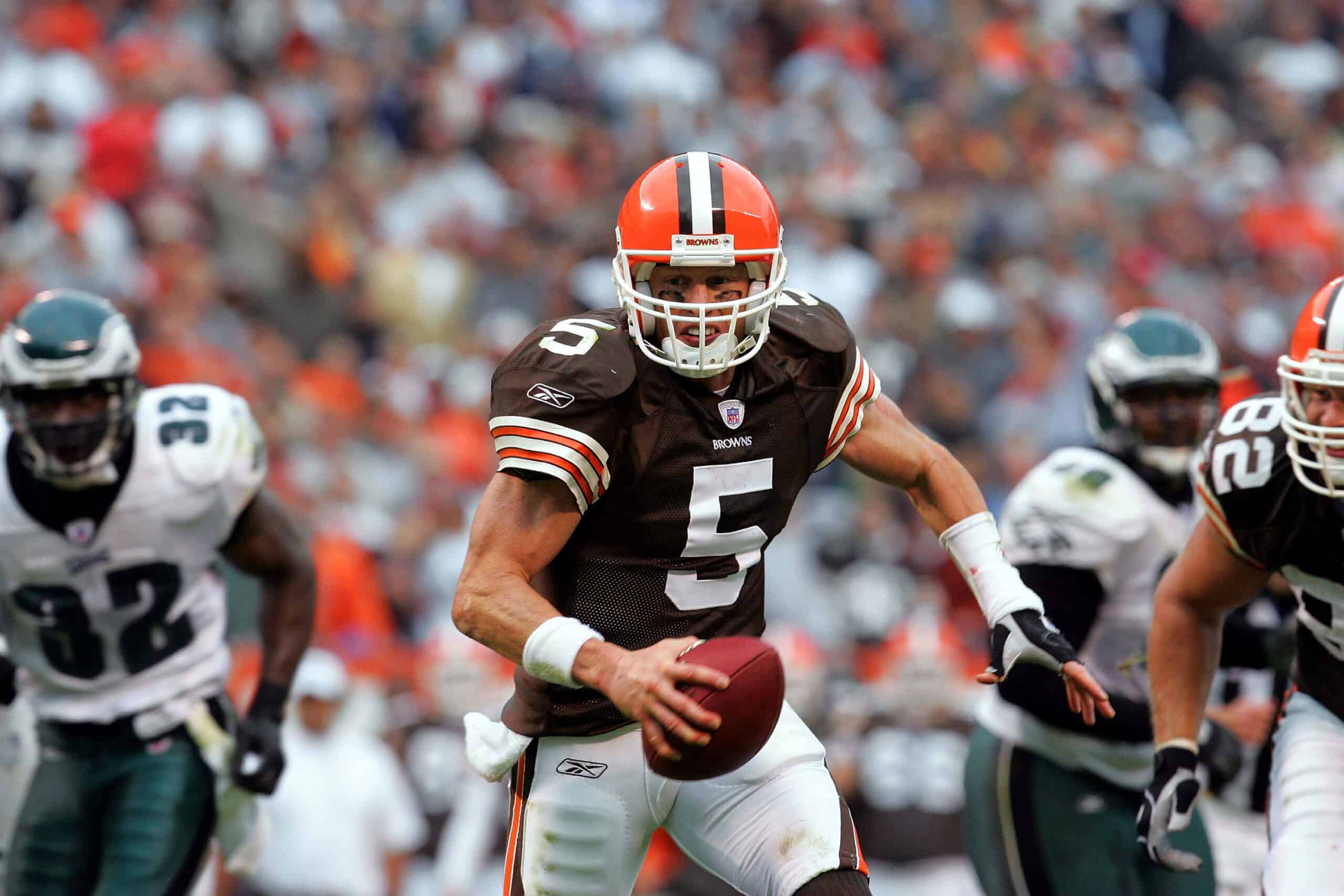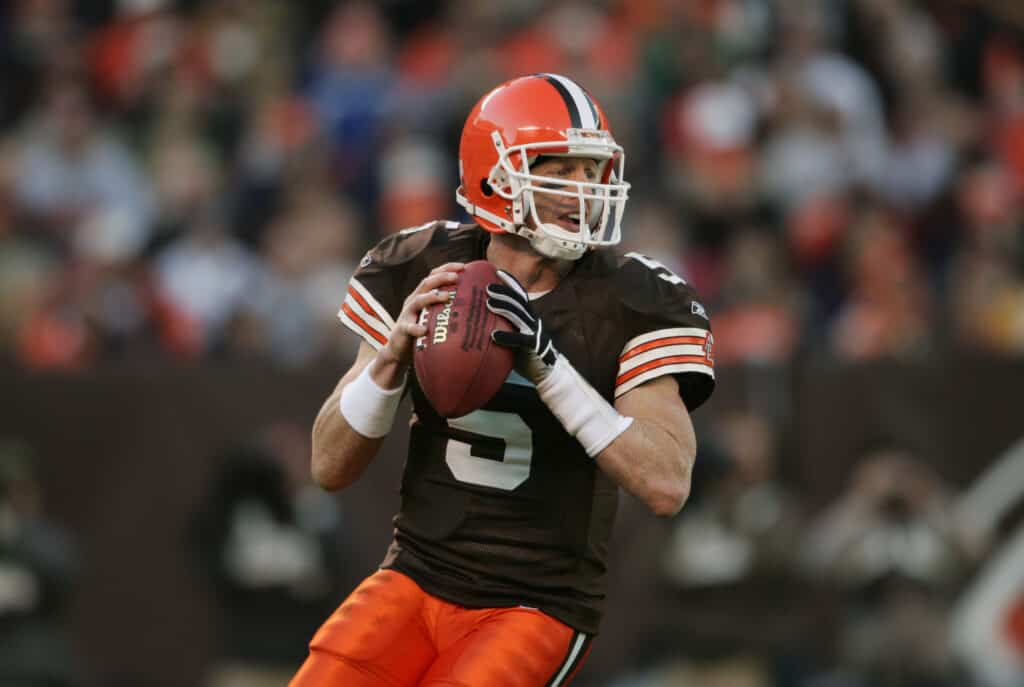When the Cleveland Browns returned to the NFL in 1999 after a three-year hiatus, they were fully aware of what they needed to succeed.
Without a doubt, finding a quarterback was at the top of their priority list.
Former Heisman winner and NFL journeyman Ty Detmer was signed to be a placeholder.
It was understood that he would play until the team’s new franchise QB was ready.
With the first pick of the 1999 NFL Draft, the Browns selected Kentucky quarterback Tim Couch.
The idea was that Couch would sit and learn from Detmer during his rookie year.
Once he was ready, Couch would take the reins.
That didn’t happen.
After two rough losses to begin the season, the coaching staff became impatient and pulled Detmer.
Couch was thrust into his pro career sooner than expected and the result was disastrous.
Over the next five years, Couch struggled to stay on the field.
Injuries and inconsistent play eventually ended his career.
Whenever Couch wasn’t on the field, the team was forced to play several other quarterback options.
The names included Doug Pederson, Spergon Wynn and Kelly Holcomb.
In fact, Holcomb and Couch evenly split the starts in 2003.
This trend of rotating quarterbacks and failed projects would continue for several more years.
However, the season after Couch’s Cleveland exit, the team brought in an experienced gunslinger to save the day.
Browns QB Jeff Garcia pic.twitter.com/DMpCxZdIW6
— Quarterback Club (@TheNewQBClub) December 14, 2015
Jeff Garcia had proved his mettle in the CFL and with San Francisco during the previous decade.
It was widely believed that Garcia’s experience and savvy would right the Browns ship.
Instead, he lasted all of ten games.
This is the story of what happened to Jeff Garcia in Cleveland.
CFL All-Star

Garcia was a three-year starter for San Jose State from 1991-1993.
Despite being named an All-America after his junior season, Garcia went undrafted by the NFL in 1994.
He was considered too small at 6’1” for the NFL and was ignored by every pro team.
Garcia then signed with the Calgary Stampeders of the Canadian Football League.
In ‘94, he was the primary backup to former Boston College great Doug Flutie.
The following year, Garcia became the starter after Flutie was injured during a game.
He played so well that, when Flutie returned, there was a quarterback controversy.
August 26, 1995
Jeff Garcia made his #FirstCFLStart for the StampedersDoug Flutie (elbow) was limited to holding on place kicks
It was an impressive debut with 445 yards passing pic.twitter.com/VPKd1myWTF
— Chris 🇨🇦🏈 Stats Junkie (@Stats_Junkie) August 27, 2021
After Flutie signed with the Toronto Argonauts in 1996, Garcia became Calgary’s full-time starter.
He immediately became a success, leading the franchise to the postseason each year.
In 1997, Garcia was awarded the Jeff Nicklin Memorial Trophy as the Most Valuable Player in the CFL’s Western Division.
By 1998, Garcia was on top of the world.
hat year, he led the Stampeders to the Grey Cup title.
Calgary won the game after Garcia led the offense on an 80-yard drive to set up the winning field goal.
He won the MVP for his exploits and that season was also selected as the 1998 CFL All-Star as quarterback.
San Francisco

Not long after the Grey Cup victory, the 49ers signed Garcia to backup Steve Young.
During the 1999 season, Young suffered a severe concussion during a game against Arizona and was sidelined for the year.
Garcia split time with Steve Stenstrom for the season.
Due to repeated concussions and injuries, Young retired after 1999.
The Niners drafted two quarterbacks in the 2000 draft, but Garcia outshined them both.
In the first seven games of the year, he threw for 19 touchdowns.
San Francisco finished the year 6-10, but Garcia played better than expected.
That season, he set a franchise passing record with 4,278 yards along with 31 touchdowns and two interceptions.
Garcia’s play led to him being selected to his first Pro Bowl.
Officially Jeff Garcia (5) days away from the NFL Draft 🙌🏼#49ers || #FTTB pic.twitter.com/OqoduHvW9D
— OurSF49ers (@OurSf49ers) April 24, 2021
In 2001 it was more of the same with Garcia throwing 32 touchdowns and passing for 3,538 yards.
He was selected for a second Pro Bowl after the season.
The Niners returned to the postseason after a two-year absence.
However, they were defeated by the Packers in the first round.
The 2002 season saw the Niners win the NFC Western Division for the first time since 1997.
Garcia passed for 3,344 yards and 21 scores.
In the division clinching game against Dallas, Garcia helped San Francisco erase a ten-point deficit to win the game and division.
During the team’s first-round playoff game against the Giants, Garcia brought his team back again.
Jeff Garcia #49ers pic.twitter.com/MwTytP4eka
— Lakeju1 (@lakeju1) October 23, 2013
This time, the Niners were behind 38-14 in the third quarter and came back to win 39-38.
The following week, the team was eliminated by Tampa Bay.
Garcia was named to his third consecutive Pro Bowl.
Before 2003, San Francisco fired coach Steve Mariucci and replaced him with Dennis Erickson.
With injuries to key personnel during the year, along with Garcia learning a new offense, the team fell apart.
On their way to a 7-9 record, Garcia passed for only 2,704 yards, 18 touchdowns and 13 interceptions.
After the ‘03 season, Garcia and the Niners parted ways.
A savior in Cleveland?

With the Browns quarterback situation looking bleak in 2004, the team moved quickly to get Garcia.
They signed him to a four-year, $25 million dollar deal and immediately named Garcia their starter.
“I want to let the Cleveland Browns know and all their fans know that this is an exciting day in my life,” Garcia said after his signing. ”Bringing my leadership and my background, I think it’s going to be a prefect blend. This game is about heart and perseverance, and that’s what I bring to the field.”
Browns coach Butch Davis was also excited about bringing Garcia in.
“…when Jeff came on the market, we got on his dance card,” Davis said at the time. “One of the things we wanted to get away from is the circus at the quarterback position that we’ve had. This provides us with a little bit of clarity in the organization and in the locker room. Jeff gives us electricity. He has leadership, charisma and passion, the type of things you can’t put a stopwatch on.”
Unfortunately, it wasn’t long before Browns fans and Davis realized the “circus” would continue in ‘04.
During a game against Dallas on September 19, Garcia completed only eight of 27 passes for 71 yards and three picks.
That gave him a career-low passer rating of zero.
There were some highlights during the short Garcia tenure.
In Week 1 versus the Ravens, the team came together to drop their division rival.
Garcia passed for 180 yards and two touchdowns on the way to a 20-3 win.
During a game against the Bengals in October, he tied a team record with a 99-yard pass completion to receiver Andre Davis.
The last time the Browns did NOT lose in Week One, their starting quarterback was…
Jeff Garcia pic.twitter.com/GX0KzQWbAX
— NFL on CBS 🏈 (@NFLonCBS) September 10, 2018
However, in a Week 11 game against the Jets, Garcia suffered a separated shoulder that knocked him from the game.
That would effectively be it for him in Cleveland.
With Garcia sidelined, the team endured a 1-6 slide to end the year 4-12.
Once the season concluded, Garcia was presented with an opportunity to reunite with Mariucci in Detroit.
Despite the Lions perpetual incompetence in the win column, and a little “assistance” from the new Browns coach, Garcia jumped at the chance to leave Cleveland.
Aftermath
Garcia’s year in Detroit did not pan out the way he would have hoped.
He did defeat Cleveland in late October.
However, Garcia eventually struggled and was relieved by Joey Harrington to end the 2005 season.
At that point, it looked like Garcia was done with pro football.
Three straight subpar seasons with three different teams did not bode well for him.
Fortunately, the Eagles brought in Garcia to back up Donovan McNabb.
He would be an insurance policy in case McNabb went down with an injury as he had the season before.
Philadelphia would look like geniuses late in the year when McNabb did in fact suffer a season-ending injury.
Garcia came in and led the team on a five-game winning streak to end the season.
The win streak helped the team take the NFC East Division.
Then, in the playoffs, Garcia helped the Eagles beat the Giants and narrowly lose to the Saints the following week.
@JeffGarciaJGFA @49ers @Eagles @STLouisRams @TBBuccaneers @Browns @LionsLion Jeff Garcia signed my @SInow Thanks! pic.twitter.com/FlBC9kJXlJ
— Mike Sorenson (@MikeSorenson1) November 12, 2015
After the season, Garcia stated that he wanted to return to Philly, but the team declined in order to avoid a quarterback controversy between Garcia and McNabb.
Garcia then signed with Tampa Bay in 2007.
During the year, he passed for 2,440 yards, 13 touchdowns and only four picks.
He propelled the franchise to an NFC South title and a ten-point loss to the Giants in the playoffs.
After the season, Garcia would be named to his fourth Pro Bowl.
In 2008, Garcia went down with an injury in Week 1.
When he returned, the Bucs decided to use a carousel of quarterbacks including Garcia, Brian Griese and Luke McCown.
The lack of cohesion at the position led to a 9-7 team record, just missing the postseason.
Tampa Bay chose not to bring back Garcia for 2009.
Over the next three years Garcia would spend time with the Raiders, Eagles (again), the Omaha Nighthawks of the United Football League and the Texans.
He would retire following the 2011 season.
What happened?
Although painful, it is interesting to look back and find out what went wrong during Cleveland’s long search for a franchise QB.
The Garcia year was vexing, but the reasons for his awful year aren’t hard to find.
Misaligned offensive system
In reality, Garcia’s play issues began in San Francisco.
Mariucci ran a style of West Coast offense that Garcia excelled in.
He was a mobile quarterback with a reliable receiver in Terrell Owens.
After Mariucci was dismissed, Erickson took over the Niners.
Erickson’s offensive history is associated with the Spread offense.
Garcia essentially had to unlearn three plus years of Mariucci’s offense and learn Erickson’s.
With injuries to key 49ers personnel in 2003, and the lack of weapons for Garcia to throw to, everything fell apart.
Former 49ers QB Jeff Garcia, seen recently at 49er games interviewing players after games, was a great QB and ran the WCO to near perfection. pic.twitter.com/IjkwNfDYck
— SemperFi_Coach (@SemperfiCoach) January 28, 2018
In Cleveland, Garcia was asked to be a pocket quarterback in coach Butch Davis’ system.
Davis’ previous Browns signal callers were Couch and Holcomb.
To put it mildly, Garcia was not Couch or Holcomb.
Long story short, Garcia was at the mercy of offensive systems that did not mesh with his skill set.
Lack of solid skill players
In San Francisco, Garcia had a talented group of offensive skill players.
Not only did he target Owens on a regular basis, but the Niners also had a solid receiver in JJ Stokes and Garrison Hearst in the backfield.
In 2004, Garcia found an offensive roster with skill players lacking in big threat capability.
(He also experienced poor offensive line play as injuries cost him six games).
Rookie tight end Kellen Winslow Jr. could have been an exciting target, but he suffered a season-ending injury two games into the year.
Without Winslow, the Browns only had receiver Dennis Northcutt as their go-to player.
Northcutt was decent (the previous year he had a career-high 62 receptions) but he was not going to propel the Browns to new heights.
Remember Dennis Northcutt?#ClevelandBrowns #DawgPound #Browns pic.twitter.com/yCupb3FY9O
— Cleveland Browns Guys (@CleveBrownsGuys) October 18, 2019
Finally, there was essentially no running game in Cleveland as William Green never cracked the 1,000-yard mark in four seasons as a pro.
Without playmakers, Garcia never stood a chance in ‘04.
Shaky coaching situation
By the time Garcia arrived in Cleveland, Davis was beginning his fourth year with the team.
The Browns made the playoffs in his second year, losing to Pittsburgh in the Wild Card round.
However, in 2003, the team regressed and finished 5-11.
Davis really only had himself to blame for the ‘03 debacle.
He was still smitten with Holcomb’s performance in the Steelers playoff loss the year before.
Davis seemed to have forgotten that Couch was the player who led the team to the postseason.
But his season ending injury at the end of the ‘02 season thrust Holcomb into the starter’s position.
In 2003, Davis began the year with Holcomb then switched to Couch.
The result was an uneven year with two starters and a failed season.
If Davis had simply started Couch to begin the season, maybe there wouldn’t have been a need for Garcia the following year.
Unfortunately, Cleveland fans never got to find out what could have been.
By the end of November ‘04, the Browns were 3-8.
Perhaps seeing the writing on the wall, Davis stepped down after the team’s Week 12 loss to Cincinnati.
Interim coach Terry Robiskie didn’t fare much better and closed out the year 1-4.
Once the season concluded, the franchise hired former New England defensive coordinator Romeo Crennel as their next head coach.
In turn, Crennel hired Maurice Carthon as his offensive coordinator.
In what must have been a revelation to Garcia, both Crennel and Carthon agreed that the QB would not be the best fit in their offense.
Time for another #Browns trivia Friday! This time we are doing a bad fact, Romeo Crennel had one of the highest QB counts. One problem for the Browns of this era was inconsistent QB play. How many different QBs started for the Browns under Romeo Crennel?
— Jacob Roach (@roachizm13) June 25, 2021
After only one season, Garcia was on to a new team.
Instability as a franchise
From their first year in 1946 through the 1995 season, the Browns were a fairly stable franchise.
They had their ups and downs in the win column, but the coaches, for the most part, experienced decent tenures.
The shortest stints for head coaches in the franchise’s history were two plus years for Forrest Gregg and a season and a half for Bud Carson.
Those anomalies aside, every other coach the team employed through ‘95 stuck around for at least four seasons.
However, once the franchise returned to the NFL in ‘99, they were the very model of instability.
Chris Palmer was the expansion coach in ‘99 and was gone after 2000.
Davis came next and had three plus seasons.
Crennel was given four years but was gone after 2008.
After Crennel, each successive head coach was employed for only two years, save for Rob Chudzinski, Freddie Kitchens (one year each) and Hue Jackson (two and a half).
This revolving door of coaches was also reflected in the team’s use of quarterbacks.
Just as the Browns management became impatient with their coaching hires, they were equally impatient with their quarterbacks.
With the exception of Couch’s 2001 season and Baker Mayfield in the present, Cleveland has had multiple starting quarterbacks every year since 1999.
Hard to believe I’ve been a fan since the Jeff Garcia era. #Browns pic.twitter.com/mIBBDk4c2y
— 3rick (@nick3rick) October 13, 2017
This is the mess Garcia found himself in 2004.
The mismanagement was just in the beginning stages then, but would soon get worse.
Who knows what could have happened had the team kept Garcia in 2005.
That season the Browns added Braylon Edwards and Josh Cribbs.
Maybe the team wins a few more games and Garcia helps lead the team to another playoff berth.
Impatience from Browns management and an unwillingness to tailor an offense to their quarterback spelled the end of Garcia’s time in Cleveland and doom for the franchise.
Poor timing in retrospect
Hindsight being 20/20, we know the reasons behind Garcia’s lack of success with the Browns.
It basically comes down to Garcia arriving at the wrong time in Cleveland.
He left San Francisco with every intention of starting over with a new team.
Garcia could have done well if a number of factors were in place.
After all, Garcia was put in a system that fit his skill set in Tampa Bay and he returned to the Pro Bowl.
There should be no doubt that he could have had the same success in Cleveland if given time and resources.
NEXT: The Life And Career Of Johnny Brewer (Complete Story)